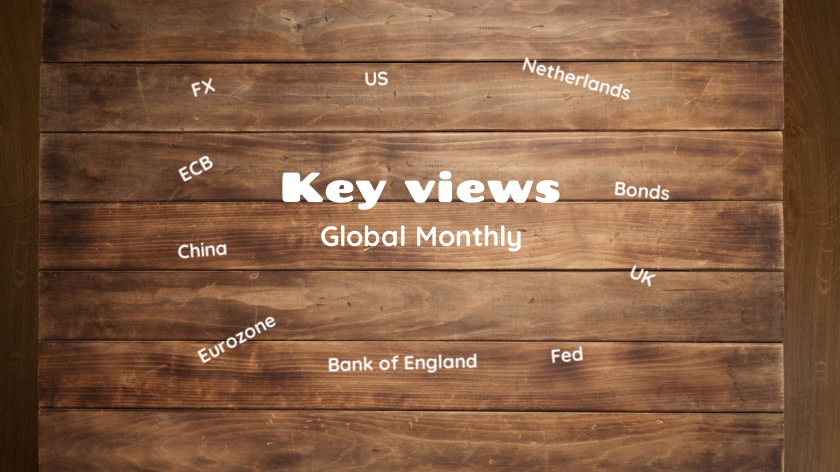Key views Global Monthly August 2025

Global growth is slowing, as the US tariff shock drives an unwind of the frontloading of exports that occurred in Q1. While the tariff hit to growth remains significant, the deals struck over the summer – to the extent that they stick – have limited the downside risks. Interest rate cuts and other forms of policy support are a cushioning factor in the eurozone and China, while in the eurozone specifically, defence spending, and in Germany new infrastructure spending will support growth in late 2025 and into 2026. Still, the nascent recoveries in domestic demand in the eurozone and China face downside risks from weaker confidence, while in the US, demand will be hit by the tariff impact on real incomes. Inflation in the US is expected to reaccelerate, but to fall below target in the eurozone. This maintains the divergence in Fed & ECB policy, with the Fed expected to keep policy in restrictive territory until 2026, and the ECB keeping rates a little above our estimate of neutral.
Macro
Eurozone
Growth in the near term is slowing on the back of US tariffs and an unwind of US export frontloading, though the recovery in domestic demand (helped by rate cuts) is a key offset. Next year, higher defence and German infrastructure spending are likely to drive higher quarterly growth. Disinflation is continuing, with services inflation falling more quickly than expected, and wage growth continuing to cool. Food prices bear close watching given their importance for expectations. Still, falling energy prices are likely to drive an undershoot of the 2% inflation target later this year, helped by a stronger euro.
The Netherlands
After the summer break, we are moving into budget and election season, with Budget day in September and Dutch elections scheduled for 29th of October. Growth in Q2 came in at 0.1% q/q, roughly in line with expectations. Due to the (in)direct effect of tariffs and related uncertainty, growth will cool over the course of 2025. In 2026, higher defence spending in the eurozone and fiscal spending in Germany, as well as rate cuts feeding through to the economy, will provide an upside to growth. Inflation will ease, but stay elevated compared to the eurozone in the coming quarters.
UK
The economy is slowing on the back of the US tariff shock, as the frontloading of trade in Q1 is unwound in Q2. Still, the UK is less vulnerable to US tariffs than the eurozone, as it is less export dependent and faces a lower tariff rate. Lower interest rates and higher government spending are also giving some support to growth. Services inflation remains stubbornly high, with wage growth still well above levels consistent with 2% inflation. The rise in food inflation is a concern for inflation expectations, which have been historically high in the UK.
US
Tariffs and elevated uncertainty continue to slow down the economy. The impact of the Trump administration's policy will gradually build in the hard data. We expect growth to slow down to 1.5% in 2025 and 1.2% in 2026. Tariffs will lead to an increase in PCE inflation to 3.1% by year end. Despite downward revisions in non-farm payrolls, deterioration in the labour market remain relatively contained as lower labour demand is paired with lower labour supply due to lower immigration. The unemployment rate only rises gradually to 4.5 by year end.
China
Q2 GDP data point to resilience, with exports holding up well during the US tariff war so far, and the ‘Geneva’ truce agreed in mid-May now extended to mid-November. Despite this (external) resilience, domestic supply-demand imbalances remain. July data generally surprised to the downside, pointing to a weaker growth momentum. Investment was hit by the recent crackdown on excessive competition. Although we marginally raised our growth forecasts, we still expect (annual) growth to slow in H2-25, and foresee more macro support aimed at stabilising domestic demand and the property sector.
Central Banks & Markets
ECB
The Governing Council kept policy on hold in July, and is likely to remain on hold for the foreseeable future. President Lagarde has said that the ECB is ‘well positioned’ to face the coming period of tariff impact and uncertainty. Despite the expected undershoot of the 2% inflation target, the GC seems minded to look through this on the expectation that inflation will return to target in 2027. Although the ECB’s inflation projections factor in one more 25bp rate cut (based on market rate expectations in June), we doubt the Governing Council is minded to fine-tune policy to that degree.
Fed
In our base case, the massive amount of uncertainty on tariff pass-through to the real economy keeps the Fed rate at 4.5%. Throughout the year, the price stability mandate will carry more weight than the employment mandate, such that the Fed will keep rates restrictive. The recent downward revision of labour market statistics has however increased the probability that the Fed will choose the employment mandate and starts gradually easing in September. Otherwise, the resumption of disinflation in the new year will allow the Fed to start easing in the first quarter of 2026, by 25bps per quarter.
Bank of England
The MPC lowered Bank Rate to 4.00% in August, in line with our expectations. Four of the nine MPC members dissented in favour of no change, reflecting the recent upside surprises in inflation and risk of inflation expectations de-anchoring. Our base case continues to see two final 25bp cuts in November and February, taking Bank Rate to 3.5%. If wage growth fails to continue normalising, and/or if inflation expectations stay elevated, the risk is for these cuts to be delayed to later in 2026.
Bond yields
The ECB's rate-cutting cycle seems to have ended, leaving little scope for German 10y yields to fall further. We expect long-term yields to face upward pressure, driven by a rising term premium in Germany, reflecting higher government spending and increased debt supply in the coming years. Meanwhile, US 10y yields remain relatively low as markets price in substantial rate cuts. However, we believe the Federal Reserve will hold its current stance, prompting a significant market repricing to align with macroeconomic fundamentals.
FX
Since EUR/USD set a high at 1.1829 on 1 July the move has lost momentum. The holiday period probably had something to do with this, and the market is looking for fresh news. Meanwhile we recently changed our ECB view (see above). Our ECB view change by itself implies a somewhat higher EUR/USD forecast, but uncertainty around the Fed path means that we prefer to keep our FX forecasts unchanged for now. Our forecast for EUR/USD end 2025 stands at 1.15 and end 2026 stands at 1.25.

